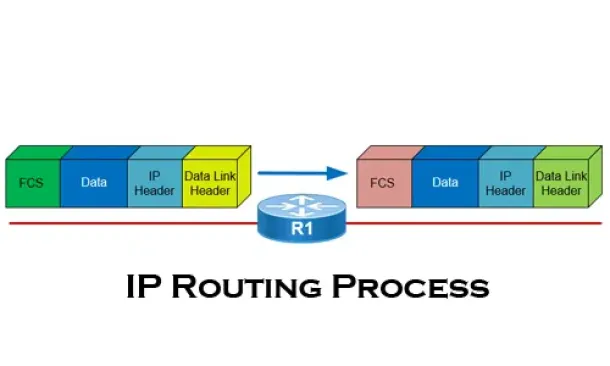
All-in-one protection for Microsoft 365
All-in-one protection for Microsoft 365


OpManager: Network & DC Monitoring
Monitor & Manage Network, Datacenters, endpoints & more.
Latest Articles
Optimizing Cisco Router Performance: Best Practices for Effective Monitoring & Network Management
 Effective monitoring and management of Cisco routers and network devices are essential for ensuring a robust and efficient network infrastructure. In this article, we explore the key features and best practices for effectively monitoring and managing Cisco routers and other network devices in real-time. By incorporating these strategies into your IT management plan, you can enhance efficiency, boost performance, and ensure the smooth operation of your entire network infrastructure.
Effective monitoring and management of Cisco routers and network devices are essential for ensuring a robust and efficient network infrastructure. In this article, we explore the key features and best practices for effectively monitoring and managing Cisco routers and other network devices in real-time. By incorporating these strategies into your IT management plan, you can enhance efficiency, boost performance, and ensure the smooth operation of your entire network infrastructure.
Key Topics
- In-depth Real-time Monitoring your Network Device Performance
- Real-time Monitoring Hardware Metrics
- Analyze Network Traffic to Understand Usage Patterns
- Effectively Manager Configuration Changes
- Visualize Network Paths and Pinpoint Network Issues
- Monitor and Manage Your Routers and other Devices with a Comprehensive Management Solution
Routers are the backbone of every network, playing a crucial role in directing traffic and ensuring that data reaches its destination efficiently. They connect various parts of a network and optimize performance by selecting the best possible route for every data packet. With a significant 34.7% market share, Cisco stands out as the leader in the router market, making its devices a common and vital part of modern network infrastructure.
Despite their importance, managing these routers can be challenging. Traditionally, network administrators must connect to each router manually using console cables and retrieve data via Secure Shell (SSH) or Telnet. This process is not only time-consuming but also prone to errors, especially in large enterprise environments where hundreds of devices require regular monitoring and maintenance.
Modern IT operations management software offers an effective solution to these challenges. By automating monitoring and management tasks, such software provides a single-pane view of the entire infrastructure, simplifying operations and reducing manual workloads. This automated approach enables organizations to quickly identify issues, streamline routine tasks, and maintain optimal network performance.
Take a peak at the market's leading IT infrastructure management & performance monitoring solution
In-Depth Real-Time Monitoring Your Network Device Performance
7 Essential Firewall Management Strategies for Maximum Security

A firewall appliance is a fundamental pillar of network security, acting as the first line of defense against cyber threats. However, its strength is only as good as its configuration, monitoring, and ongoing maintenance. A poorly managed firewall is like a high-security vault with a weak lock—inviting trouble. Simply deploying a firewall isn’t enough; effective management is essential to ensure it remains a robust safeguard rather than a security blind spot.
Proper firewall administration involves real-time traffic monitoring, rule-set optimization, and timely updates to block evolving threats while allowing legitimate access. Without these crucial practices, even the most advanced firewall can become a liability, leaving your network exposed to exploitation.
To fortify your cybersecurity posture, here are seven essential best practices for effective firewall management.
Key Topics:
- Routing Testing and Patch Management
- Firewall Policy Optimization
- Monitor Firewall Performance
- Log Monitoring and Alerts
- Backup Firewall Rule Sets & Configuration
- Policy Decision-Making
- Periodical Reviewing of Firewall Access Controls
- Summary
Download your copy of the industry's leading Firewall Management Platform.
Routine Testing and Patch Management
Routine Testing: Your firewall needs regular testing to ensure it is working effectively. The testing includes vulnerability scanning, penetration testing, and compliance audits to identify weaknesses, simulate attacks, and ensure alignment with security standards.
Patch Management:Firewalls may develop vulnerabilities as time passes. Patch management is the process of installing updates and patches to fix these security weaknesses. It is essential to consistently update the software and firmware of your firewall to defend against new threats and maintain peak performance.
Example: Applying the most recent vendor patch when routine testing reveals a new vulnerability in your firewall software can help reduce this risk and improve the security of your network.
How to Protect Your Business with Microsoft 365 Security Tools
 Businesses of all sizes are more and more adopting cloud-based platforms like Microsoft 365 to streamline operations, improve collaboration, and increase productivity. However, this newfound reliance on such software solutions makes these businesses prime targets for cybercriminals.
Businesses of all sizes are more and more adopting cloud-based platforms like Microsoft 365 to streamline operations, improve collaboration, and increase productivity. However, this newfound reliance on such software solutions makes these businesses prime targets for cybercriminals.
With sensitive data stored and shared across the suite, securing your Microsoft 365 environment is essential to protect your business from potential threats.
Fortunately, Microsoft 365 comes with a robust set of built-in security tools designed to safeguard your organization from cyberattacks, data breaches, and other security incidents.

But despite that, we cannot ignore the importance of third-party Microsoft 365 total protection solutions. Without going too much into detail, these solutions enhance the already powerful native security features. But what are these features?
In this article, we’ll explore the key Microsoft 365 security tools you can use to protect your business.
Key Topics:
- Key Microsoft 365 Security Tools
- Best Practices for Leveraging Microsoft 365 Security Tools
- Conclusion
Related Articles:
- Boost Your Microsoft 365 Security with Expert Guidance and Proven Best Practices
- Empowering Users with Cyber Security Awareness Training
Key Microsoft 365 Security Tools to Protect Your Business
Microsoft Defender for Office 365
 One of the most critical security solutions within the Microsoft 365 ecosystem is Microsoft Defender for Office 365. This tool is specifically designed to protect against email-based threats such as phishing, malware, and ransomware, which are common attack vectors targeting businesses.
One of the most critical security solutions within the Microsoft 365 ecosystem is Microsoft Defender for Office 365. This tool is specifically designed to protect against email-based threats such as phishing, malware, and ransomware, which are common attack vectors targeting businesses.
Defender for Office 365 leverages real-time threat intelligence to detect and block malicious activity before it reaches your users.
Key features include:
Unlock Deep Visibility & Insight into Windows Server 2022 Logs
 This article explores the exciting new features of Windows Server 2022 and emphasizes the critical role of analyzing Windows Server logs. You'll also discover how EventLog Analyzer provides comprehensive, helps you achieve 360-degree protection against threats targeting these logs, ensuring robust security for your server environment.
This article explores the exciting new features of Windows Server 2022 and emphasizes the critical role of analyzing Windows Server logs. You'll also discover how EventLog Analyzer provides comprehensive, helps you achieve 360-degree protection against threats targeting these logs, ensuring robust security for your server environment.
Key Topics:
- The Importance of Proactive Log Management
- Windows Server 2022 and its Key Features
- Understanding Windows Server Logs
- The Importance of Analyzing Windows Server Logs
- Benefits of Using EventLog Analyzer for Windows Server Log Analysis
- Configuring EventLog Analyzer to Connect to Windows Server
- Summary
Related Articles:
- Event Log Monitoring System: Implementation, Challenges & Standards Compliance
- Detecting Windows Server Security Threats with Advanced Event Log Analyzers
The Importance of Proactive Log Management
Did you know that threats targeting Windows Server and its logs are becoming more significant? To protect your systems, you must monitor and analyze these logs effectively. Ensuring system security, compliance, and health requires effective log management.
Administrators can ensure optimal performance by promptly identifying and resolving issues through routine log review. Log analysis also protects sensitive data by assisting in the detection of any security breaches and unwanted access. Proactive log management ultimately improves the security and dependability of the IT infrastructure as a whole.
EventLog Analyzer monitors various Windows event logs, such as security audit, account management, system, and policy change event logs. The insights gleaned from these logs are displayed in the forms of comprehensive reports and user-friendly dashboards to facilitate the proactive resolution of security issues.
Windows Server 2022 and its Key Features
Windows Server 2022 is a server operating system developed by Microsoft as a part of the Windows New Technology family. It is the most recent version of the Windows Server operating system, having been released in August 2021. Large-scale IT infrastructures can benefit from the enterprise-level administration, storage, and security features offered by Windows Server 2022. Compared to its predecessors, it has various new and improved capabilities, with an emphasis on application platform advancements, security, and hybrid cloud integrations.
Let’s take a look at a few key features of Windows Server 2022:
- Cutting-edge security features, such as firmware protection, virtualization-based security, hardware roots of trust, and secured-core servers, that protect against complex attacks.
- Improved management and integrations with Azure services via Azure Arc's support for hybrid cloud environments.
- New storage features, which include Storage Migration Service enhancements, support for larger clusters, and improvements to Storage Spaces Direct.
- Enhancements to Kubernetes, container performance, and Windows containers in Azure Kubernetes Service to improve support for containerized applications.
- Support for more powerful hardware configurations, including more memory and CPU capacity, with enhanced performance for virtualized workloads.
- File size reductions during transfers to increase efficiency and speed through the use of Server Message Block (SMB) compression.
- An integration with Azure Automanage for easier deployment, management, and monitoring of servers in hybrid and on-premises environments.
- Improved networking features, such as enhanced network security and performance as well as support for DNS over HTTPS.
- Enhanced VPN and hybrid connectivity options, such as an SMB over QUIC capability that permits safe, low-latency file sharing over the internet.
- Improvements to Windows Subsystem for Linux and tighter integration for cross-platform management, which provides better support for executing Linux workloads.
- A range of flexible deployment and licensing options, such as the usage of Azure's subscription-based licensing.
- Support for modernizing existing .NET applications and developing new applications using the latest .NET 5.0 technologies.
- Enhanced automation capabilities with the latest version of PowerShell, PowerShell 7.
Understanding Windows Server Logs
Windows Server event logs are records of events that occur within the operating system or other software running on a Windows server. You can manage, observe, and troubleshoot the server environment with the help of these logs. The logs capture numerous pieces of information, such as application problems, security incidents, and system events. By examining and evaluating these logs, administrators can ensure the security, functionality, and health of the server.
Your IP address:
78.246.161.48
Wi-Fi Key Generator
Follow Firewall.cx
Cisco Password Crack
Decrypt Cisco Type-7 Passwords on the fly!
Featured Categories:
Top Picks:
SysAdmin Day 2020 - Get your Free Amazon Vouche...

Elevate your network management: Maximizing eff...
6 Key Areas to Consider When Selecting a VM Bac...

Challenges & Solutions to Managing Firewall Rul...
Security Service Edge (SSE) Limitations & Disadvantages. Protecting all Traffic, Users, Apps, and Services with 360-degree SSE
The Need for a Converged SASE Platform. Converging Network & Security Services with Catonetworks SASE Platform
Understanding Secure Access Service Edge (SASE) and how it integrates with SD-WAN
WAN Optimization vs SD WAN Networks. Today’s Challenges & Difficulties for WAN Optimization

Static VLANs

The VLAN Concept - Introduction to VLANs

VLAN Security - Making the Most of VLANs

VLANs - Access & Trunk Links

OSPF - Part 3: OSPF Adjacency & Neighbor Forming Process. OSPF Hello Messages, OSPF Database Updates via Link State Requests (LSR & LSU)

Routed Protocols

The IP Routing Process - Step-by-Step Analysis


















